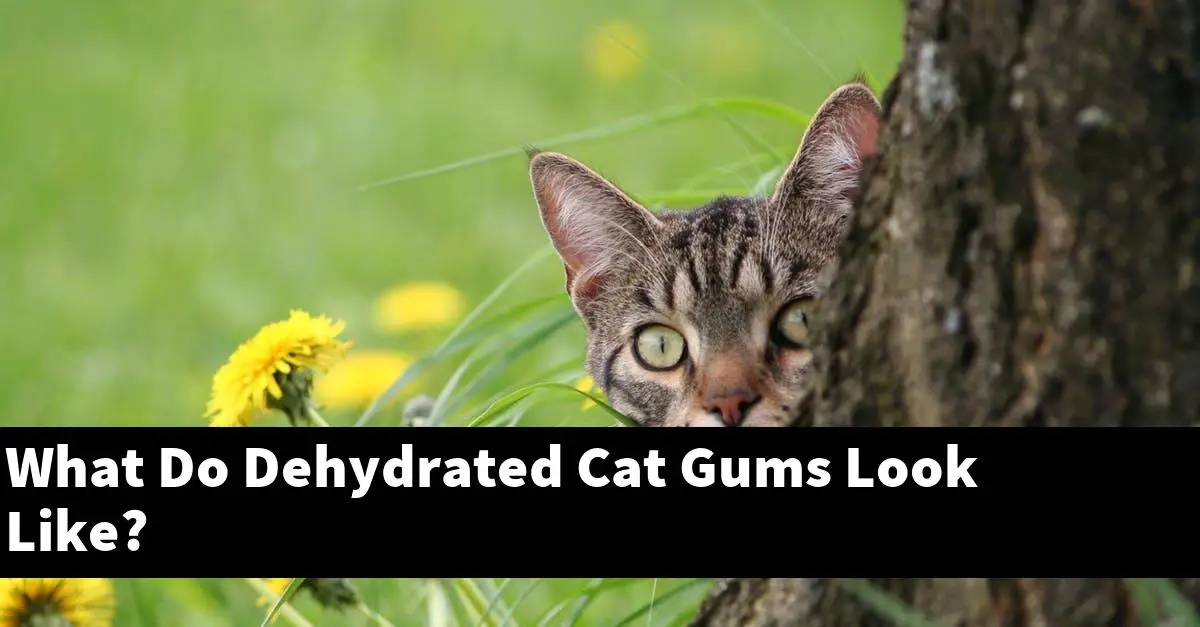Dehydrated cat gums can look dry, cracked, and peeling. The gums may also be a different color than usual, ranging from pale to bright red.
If your cat’s gums are dehydrated, it is important to seek veterinary care as soon as possible.
Can dehydration cause pale gums in cats?
One potential cause of pale gums in cats is dehydration. Dehydration can cause the blood vessels in the mouth and gums to shrink, which can lead to a pale appearance.
In some cases, dehydration may be the result of a lack of water or food, or from a medical condition. If dehydration is severe, it may lead to a condition called kennel fever, which can cause extensive damage to the skin and hair around the mouth.
If your cat is showing signs of dehydration, make sure he is getting enough water and food, and contact your veterinarian if the condition persists.
What color gums should a cat have?
It depends on a cat’s individual personality and dietary preferences. Some cats may prefer brightly-colored gums while others may prefer more muted colors.
Some cats may also prefer different colors for different parts of their mouth – for example, one cat might prefer blue gums near the front of their mouth, while another cat might prefer pink gums near their tongue. Ultimately, the color of a cat’s gums is a personal preference that should be respected.
What color are cats gums when sick?
The color of a cat’s gums when sick can vary depending on the cause of the illness. For example, if a cat has a virus, their gums may be a light pink or red.
If a cat has a bacterial infection, their gums may be a darker pink or red.
How do you know if your cat needs fluids?
There is no single answer to this question as it depends on the individual cat, their medical history, and the symptoms they are exhibiting. However, generally speaking, if a cat is not eating or drinking, or is displaying signs of dehydration such as panting or decreased energy, they may need fluids.
It is important to consult with a veterinarian if you are unsure as to whether or not your cat needs fluids.
What do pale gums look like in a cat?
The gums on a cat’s teeth may look pale or slightly yellowish due to the lack of blood flow to the tooth due to a lack of oxygen.
How do you know if a cat’s dehydrated?
There are a few signs that your cat may be dehydrated. One is if their gums are pink or red, which is a sign of blood loss.
Another sign is if your cat is not drinking or eating enough. Finally, a dehydrated cat may have a decrease in energy and a decreased appetite.
Are white gums on cats bad?
It depends on a variety of factors, including the individual cat’s dental history and diet. Some people believe that white gums on cats may be a sign of dental disease, while others believe that white gums on cats are simply a sign of healthy teeth and gums.
Ultimately, it is best to consult a veterinarian to get a definitive answer.
What color should a black cats gums be?
A black cat’s gums should be a light blue or light purple, in order to match their coloration.
What are the symptoms of liver failure in cats?
Liver failure in cats is characterized by jaundice, lethargy, and poor appetite. The animal may also have yellowing of the whites of the eyes and skin, clayey stools, and a decreased ability to fight infection.
The cat may also experience rapid heart rate, shallow breathing, and a decreased blood pressure. If left untreated, liver failure can lead to death.
Is it normal for cats to have black gums?
There can be a variety of causes for black gums in cats, but the most common is a problem with their teeth. If the teeth are not evenly spaced or if they are not aligned properly, plaque can build up and cause the gums to turn black.
Other causes of black gums in cats include diabetes, heart disease, and other medical conditions. If your cat has black gums and you are unsure of the cause, it is best to consult with a veterinarian.
Why do cats gums turn white?
Cats gums do not turn white as a result of tooth decay; rather, white patches on the gums are a sign of inflammation or infection. The bacteria that causes gum disease can cause white patches on the gums and tooth decay can also cause tooth loss.
When plaque, bacteria, and food accumulate on the teeth and in the spaces between the teeth and gums, the bacteria can cause inflammation. This inflammation can lead to the formation of white patches on the gums.
Should a cat’s gums be black?
It can depend on a variety of factors, including the age and health of the cat, the type of food the cat is eating, and the amount of saliva the cat is producing. Some people believe that black gums may indicate that a cat is eating a high-quality diet, while others believe that black gums are simply a sign of good oral hygiene.
Ultimately, it is up to the individual veterinarian or pet insurance company to decide whether or not to perform a routine dental check on a cat.
Conclusion
Dehydrated cat gums are often bright red in color and may be swollen or cracked. The gums may also appear dry and/or tacky to the touch.
In severe cases, the gums may pull away from the teeth (recede), exposing the roots. If you suspect your cat is dehydrated, it is important to seek veterinary care immediately as dehydration can lead to serious medical complications.


